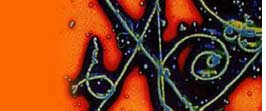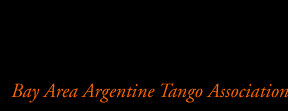NORA DINZELBACHER
The First Lady of Bay Area Tango
by
Nancy Friedman
© 2003 Nancy Friedman
“If you’re serious about tango,”
someone told me soon after I took my first lessons, “eventually you must study
with Nora Dinzelbacher.”
“Eventually” came several months later.
I stumbled upon one of Nora’s group classes
(stumbling being my signature tango move) before a milonga at the Lake
Merritt Dance Center.
Frankly, I was intimidated—by
Nora’s magnificent looks (that luxuriant black hair, that commanding
stance), by her reputation as a perfectionist, and by her gorgeous footwork,
which put me in mind of Kurt Vonnegut’s
famous line (in a completely different context) about “dancing lessons from
God.”
The class was a revelation—and
a relief. Without ever dumbing down her instruction, Nora
imparted the essential simplicity of tango as well as its elegance. And her
patient critique of my dancing included some advice I’ll never forget.
“Although you are connected with your partner, you must support your own
weight,” she told me. “The woman always dances her own dance.”
The incarnation of that advice, Nora
Dinzelbacher has
been dancing her own dance for more than 30 years. As performer, teacher, Tango
Week impresario, and charter member of BA Tango, she has been a true pioneer of
Argentine Tango in Northern California. She is, in fact,
the community’s “founding mother,” without whom it’s unlikely the Bay Area (or Sacramento,
for that matter) would have so many excellent dancers, teachers, and milongas.
© 2003
Nancy Friedman
510
652-4159
“She’s the very best,” says Ed
Loomis, who began his tango studies with Nora
in 1994 and who now teaches tango in Sacramento.
Max (Maxine) Garrett
seconds that opinion. “Nora has always stayed
true to herself and to her own vision of a mutually supportive community,” she
says. Max, who first studied with Nora
in 1988 and who today assists at many of Nora’s
classes and milongas, adds: “There have been times when departing from her
values might have earned her more money or fame, but she’s never been willing
to do that. And here she is today—doing very well.”
The accidental tanguera
So it’s surprising to learn
that Nora came to tango by accident. Born in La
Paz, Entre Rios,
some 600 miles north of Buenos Aires,
she learned Argentine folk dances as a child but came to Buenos
Aires at eighteen with the goal of becoming a radio
talk-show host. When she flunked the audition—her accent was deemed too
provincial—she entered the National School of Dance, studying folk dancing (but
not tango) and learning to teach dance.
One day the school’s celadora (teacher’s aide) mentioned to Nora
that her boyfriend was looking for dancers for a professional troupe. “Come to
the show, then decide if you’re interested,” said the celadora. But Nora arrived too late and was turned away.
Time
passed, and Nora forgot about the offer. Then one of her
music teachers began directing a new show that embarked on a nationwide tour.
When the show came to Nora’s
home town of La
Paz, Nora invited the company to stay at her family’s
house. And it was there that she met the show’s dance
© 2003
Nancy Friedman
510
652-4159
director, Raul Dinzelbacher. “I fell in love the first time I saw him,”
she said. There was just one hitch: Raul, it turned out, was the celadora’s boyfriend.
A week later, while still in La Paz, Nora received a call from her
best friend. “Raul is auditioning women dancers,” the friend
said. “He needs one more, and he’s been trying to reach me.” “I was on
vacation,” Nora recalls. “So I stupidly told my friend,
‘Can’t he wait for me?’” Her friend went to the audition instead—and got the
job.
Luckily,
Nora got a third chance to dance with Raul Dinzelbacher’s troupe. The show performed on an American
cruise ship while it was docked in Buenos Aires, and Nora went to see the show—and Raul. “He immediately asked me if I knew how to
dance tango, milonga, and chacarera. I said yes—a
lie! He said, ‘If you can fit into these clothes, you’re dancing tonight.’ I
said, ‘Why not?’”
As
it happened, just two hours earlier Raul had broken up with his dancer girlfriend,
and he needed a replacement. “If I’d thought about it for two seconds, I
wouldn’t have done it,” Nora
says. “I made my professional debut that night.” She was twenty years old and
had never danced tango before.
On-the-job training
In Raul’s
company, Nora
learned choreography, costume design, stage lighting, and company
management—all on the job. And she developed her teaching style. “Raul
was a very good teacher, but he preferred that I deal with the dancers
during rehearsals,” she says. She began performing as well,
© 2003
Nancy Friedman
510
652-4159
but never with Raul.
“We didn’t become dance partners until I learned how to deal with him,” she
says. “He was a workaholic and very temperamental, and so am I.”
This
was the 1970s, when tango was out of favor among young Argentines. “My friends
danced in discos,” she recalls. “They thought tango was low-class. They’d look
at me and say, ‘Poor thing!’ But I was happy. I was on the stage every day,
getting paid for doing something I loved.”
In 1986, Raul proposed a vacation—their first. It turned
out to be a working vacation, performing on a cruise to the United States, but still, says Nora, “it was the honeymoon we’d never had.”
When they reached San Francisco—sailing under the Golden Gate Bridge at night—they said to each other, “We have
to stay here!” And they did, for six months.
During
their stay they met Jean-Louis and Marta
LeRoux—he was the conductor of the San Francisco
Ballet Orchestra; she was originally from Uruguay—with whom Nora and Raul stayed in touch after they reluctantly
returned to Buenos
Aires.
In 1988, Marta sent them a letter urging them to return to
San
Francisco.
Tango Argentino—the first major tango stage show—had come
back to San
Francisco
for a return engagement, and Marta
predicted that tango “is going to be huge here.” This time, Nora didn’t need to be asked three times. She
and Raul sold “everything we had,” and moved to San Francisco.
Twists of fate
Marta’s
prediction had been accurate. Tango
Argentino
was a sensation, and the Bay Area public clamored for tango lessons. By the
time the show left, Nora
and Raul had established themselves. Their visas
expired; they stayed
© 2003
Nancy Friedman
510
652-4159
anyway. (Eventually, after spending “thousands of dollars on immigration
lawyers,” they won visas in a lottery. Later still, Nora applied for U.S. citizenship; her status is pending.)
Among their early Bay Area students are some dancers still active in the
community: Barbara and Al Garvey, Polo Tanir, Emilio Flores (who had first learned tango not in Buenos Aires but in Los Angeles), and Jorge Allende. Classes were held in San Francisco at the Mission Cultural Center, where Nora still teaches, and at Fort Mason; and at Studio J in Berkeley, around the corner from the present-day
Beat. “There were maybe 15 of us in the whole tango community in those early
days,” Barbara
Garvey recalls. Barbara and Al also remember a tango cabaret in the
Mission District, Sociedad Gardeliana, that Nora and Raul started.
Their
reputation grew, and in 1989 they got an invitation to teach at a dance week in
Cincinnati. The other nine dances on the schedule were
vintage dances (“I had no idea what that meant!” Nora says); Richard Powers, the event director, wanted to introduce Argentine Tango. The
experiment was a success. The following year, Richard moved his dance week to Stanford University, and he asked Nora and Raul to join him.
Monday
and Tuesday of Stanford Dance Week went well, Nora recalls. Then, on Wednesday, after a full
day of teaching, Raul suffered a heart attack in their kitchen,
and died.
Nora
was devastated. “He was 40 years old—in perfect health one second, and then
it’s over. There’s no way you can prepare for something like that.”
© 2003
Nancy Friedman
510
652-4159
To save her sanity, she threw herself into work. She went back to Stanford to teach, then put
together a performance troupe and taught group and private
lessons. And she taught at a Seattle dance week, bringing along George Guim, a student she promoted to assistant. He
remained Nora’s assistant for five or six years, then
began teaching on his own.
Tango Week is born (and reborn)
In
1991, Richard
Powers re-entered Nora’s life with a tempting offer: to transform
Stanford Dance Week into Stanford Tango Week. Would Nora be interested in teaching?
!Por
supuesto! Tango Week became an institution
that lasted through 1997, when Stanford’s dance department
made an abrupt decision to cancel it. Not wanting to forfeit the good will that
Tango Week had created over the years, Richard
asked Nora if she would continue the tradition.
Determined but lacking funds, Nora
turned to Bob Moretti, a former student who
had become a good friend. “Bob said he needed to
know how much. I hadn’t even thought about it! I called Richard
and he said, ‘This much.’ I told Bob, and he
said, ‘Go ahead.’”
In 1998, Nora’s
Tango Week debuted at the Holiday Inn in Emeryville with Nora
and Bob as co-producers. The opportunity to study
with world-class maestros such as Nito and Elba,
Los Dinzel,
and Oscar Mandagarán attracts students from all over the United
States as well as from Switzerland,
Saudi Arabia, Italy,
and South Africa.
There are also usually between 28 and 40 students from Japan.
© 2003
Nancy Friedman
510
652-4159
“Lead with your heart”
The rest of the year, Nora
maintains a demanding schedule of classes (in San Francisco, at the YMCA in Palo Alto, and at the Allegro Ballroom in
Emeryville), a monthly milonga in Palo Alto, and private lessons and
workshops. (In the mid-1990s she also taught two days
a week in Sacramento.) She recently added a women’s technique
class to her Wednesday-night schedule at the Mission Cultural Center in San Francisco.
Perhaps most importantly, Nora
herself is always studying and learning—during Tango Week and on regular visits
back to Argentina. “Although her teaching is always growing,
she has never departed from a coherent methodology,” notes Max Garrett. “It’s based not on choreography but on communication—how to lead by
transferring the follower’s weight, how to understand a lead and answer it with
your body, not your arm.”
Nora
herself, when asked the most important thing for a tango student to remember,
says simply, “Put it in your heart. Lead with your heart, not your mind. The
heart communicates in the best of all languages: body language. If you have it
in your heart, you will do it sooner or later.”
Simple…yet maddeningly difficult. Fortunately for those of us in the Bay Area
tango community, we have Nora Dinzelbacher to show us the way.
##



